Routes Of Drug Administration Important Notes
1. Routes of drug administration
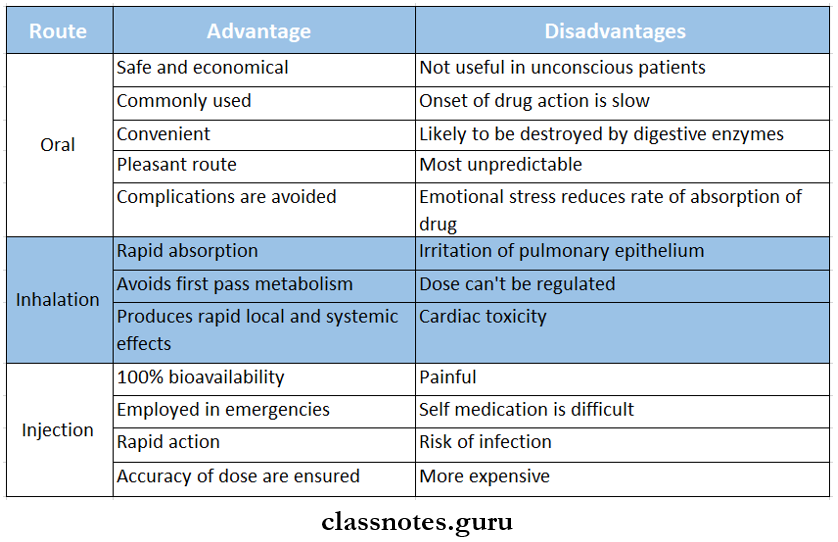
Drug administration routes MCQs with answers
Read And Learn More: Pharmacology Question and Answers
2. Parenteral routes
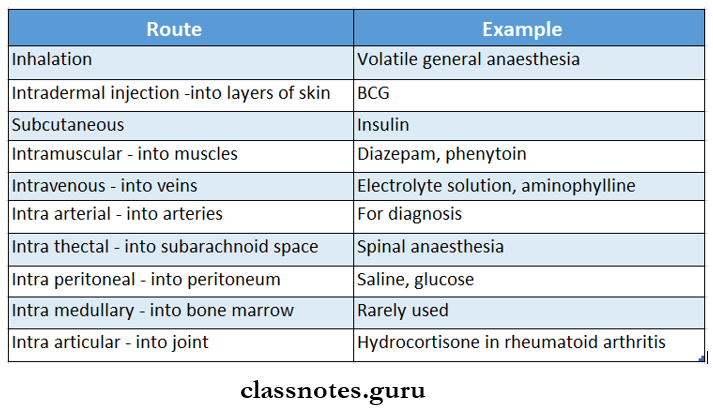
3. Transcutaneous routes are:
- lantophoresis
- Jet injections
- Adhesive units
Pharmacological Principles
4. Transmucosal routes are:
- Sublingual – Example: nitroglycerine
- Trans nasal – Example: dDAVP
- Trans rectal – Example: indomethacin, aminophylline
5. Drugs that should not be given by IV route are
- Paracetamol
- Diclofenac
- Chloroquine
- Adrenaline
Routes of drug administration questions and answers
6. Prodrug
- They are inactive as such and need conversion in the body to one or more metabolites
- Advantages
- More stable
- Better bioavailability
- Fewer side effects.
- Less toxicity
- Examples:
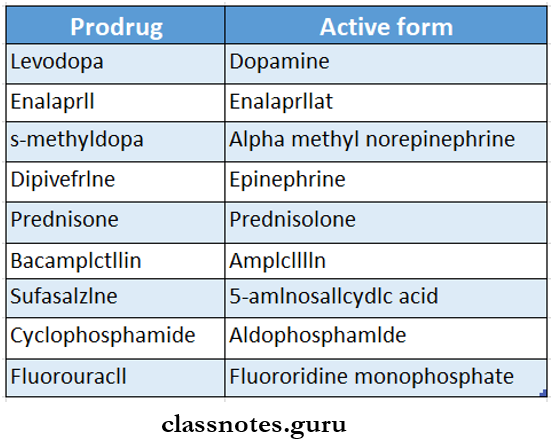
Routes Of Drug Administration Long Essays
Question 1. Describe various routes of drug administration their merits & demerits with suitable Examples.
Answer:
Routes of Drug Administration:
Pharmacological Principles
1. Routes of Drug Administration Systemic:
- Oral/enteral
- Parental Includes.
- Subcutaneous
- Intramuscular
- Intravenous
- Intradermal.
- Sublingual.
- Rectal.
- Cutaneous.
- Inhalation.
2. Routes of Drug Administration Local:
- Topical
- For deeper tissues
- Arterial supply.
Routes of administration short notes and Questions & Answers

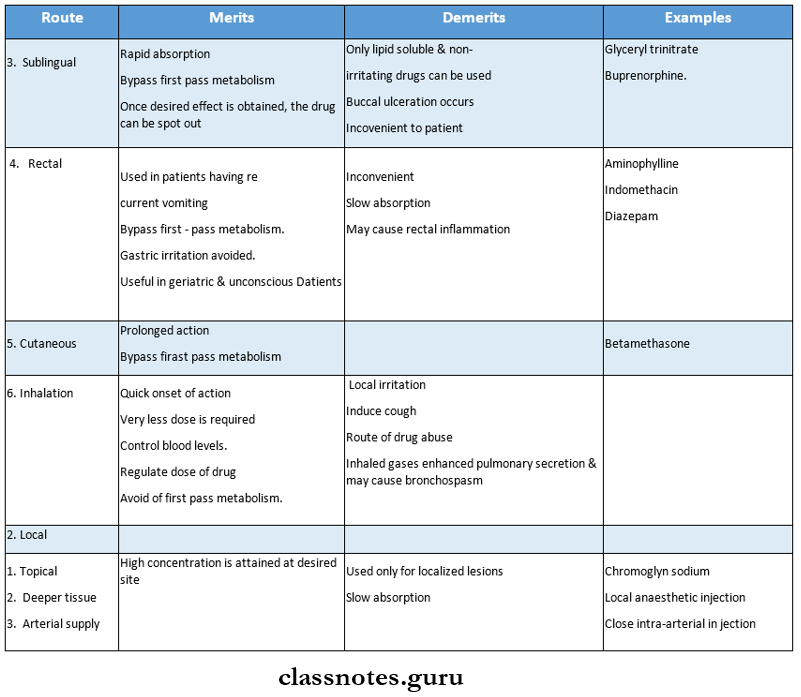
Question 2. Discuss the intravenous routes of administration.
Answer:
Oral Route of administration:
- Oral Route of administration is the most commonly used route.
- Oral Route of administration effectiveness is facilitated by.
- The large surface area of the GIT.
- Mixing of its contents.
- Differences in pH at different parts of the gut.
Intravenous Route of administration :
- Intravenous Route of administration is a type of parenteral drug administration where.
- Drugs are injected directly into the bloodstream through veins.
- Drugs are injected as a bolus or infused slowly over hours into superficial veins.
Classification of drug administration routes questions
Pharmacological Principles
Routes Of Drug Administration Short Essays
Question 1. Sublingual route of administration
(or)
Mention different routes of drugs. Write in detail about the sublingual route.
Answer:
Sublingual Route of administration:
- The tablet or pellet is placed under the tongue.
- When the drug is dissolved, it is directly absorbed across the sublingual mucosa.
- But the drug should be lipid soluble.
Sublingual Route of administration Merits/Advantages:
- Rapid absorption.
- Once desired effect is achieved, the drug can be spat out.
- Bypass first-pass metabolism by the liver.
Sublingual Route of administration Demerits/Disadvantages:
- Incoveneint to patient.
- Only lipid-soluble, nonirritating drugs can be given.
- May cause buccal ulceration.
Sublingual Route of administration Examples:
- Glyceral trinitrate.
- Buprenorphine.
- Desamino-oxytocin.
Routes Of Drug Administration Short Answer
Question 1. Enumerate routes of administration with suitable Examples.
Answer:
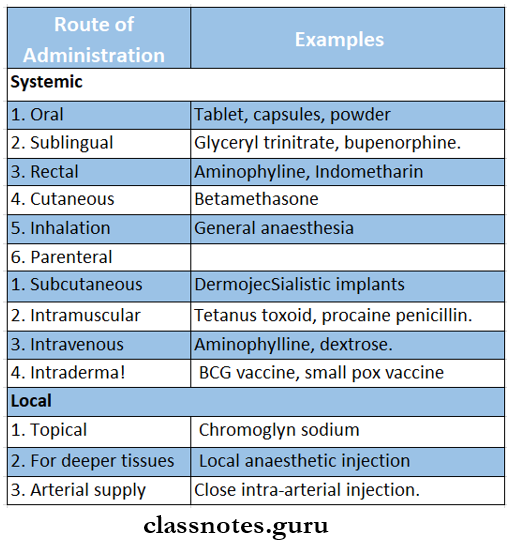
Question 2. Enteric-Coated Tablets.
Answer:
To make the drug more acceptable through the oral route, tablets are coated with substances like cellulose acetate, phthalate, gluten, etc.
These are not digested by gastric acid but get disintegrated in the alkaline juices of the intestine.
Enteric-Coated Tablets Advantages:
- As it is not digested by gastric acid, it prevents gastric irritation.
- Avoid the destruction of drugs by the stomach.
- Retard absorption.
- Prolong duration of action.
- Provide a higher concentration of the drug in the small intestine.
- Reduces frequency of administration.
- Maintain the therapeutic concentration of the drug.
Enteric-Coated Tablets Disadvantages:
- Expensive.
- Failure of preparation causes the release of the entire drug within a short time.
- This leads to toxicity.
Parenteral and oral routes questions and answers
Question 3. Parenteral Route.
Answer:
It refers to a drug injected directly into tissue fluid or blood without having to cross the intestinal mucosa.
Parenteral Route Advantages:
- Rapid action.
- Can be used in unconscious & uncooperative patients.
- Avoid gastric irritation.
- Used in patients who are unable to swallow tablets.
- Bypass first-pass metabolism.
- No interferences of gastric juices.
Parenteral Route Disadvantages:
- More chances of systemic toxicity.
- Invasive, painful.
- Preparations have to be sterilized.
- Assistance required.
- Examplepensive.
- Injury to nerves & other tissues may occur.
Parenteral Route Routes – include:
- Subcutaneous.
- Intradermal.
- Intramuscular.
- Intravenous.
Question 4. Intravenous route.
Answer:
Intravenous route Examples:
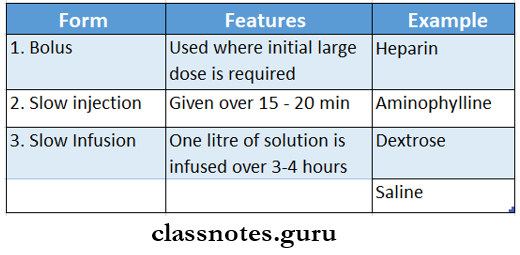
Question 5. Transdermal route.
Answer:
The transdermal route requires adhesive units.
Pharmacological Principles
- These are adhesive patches of various shapes and sizes which deliver the contained drug at a constant rate into systemic circulation via stratum corneum of epithelium.
- The drug is held in a reservoir between an outer layer and a porous membrane.
- The membrane is smeared with an adhesive impregnated with a priming dose of the drug.
- The drug is protected by another film which is to be peeled off just before application.
- The drug gets diffused for percutaneous absorption into circulation.
Transdermal route Advantages:
- Prolonged duration of action.
- Good patient compliance.
- Provide contsnt plasma drug eleves.
Transdermal route Disadvantage:
- Local irritation & erythema may occur.
- Sites of Application:
- Chest, abdomen, upper arm, back mastoid region, and scrotum.
Transdermal route Examples:
- Hyoscine
- Nitroglycerine
- Fentanyl
- Nicotine
- Estradiol.
Routes of administration viva questions
Question 6. Inhalation.
Answer:
Volatile liquids and gases are given by inhalation.
Inhalation Mechanism:
- Inhaled gases may act on the pulmonary epithelium and mucous membranes of the respiratory tract.
- They are absorbed through these membranes.
- When administration is discontinued, the drug diffuses back and is rapidly eliminated in Examplepired air.
Inhalation Examples:
- General Anaesthesia, salbutamol.
Question 7. New drug delivery system.
Answer:
- Ocusert.
- They are thin elliptical units that contain the drug in a reservoir which slowly releases the drug through a membrane by diffusion.
- Example: Pilocarpine used in glaucoma.
- Transdermal patches.
- The drug is held in between an outer layer and a porous membrane.
- Example: Fentanyl.
- Progestasert.
- Inserted into the uterus for delivering progesterone.
- Prodrug.
- The inactive form of the drug gets metabolized to an active form.
- Example: levodopa.
- Computerized miniature pumps.
- Programmed to release drugs at a definite rate.
- Example: insulin.
Advantages and disadvantages of different drug routes
Question 8. Prodrug.
Answer:
- Prodrug is an inactive form of a drug that gets metabolized to the active derivative in the body.
Prodrug Advantages:
- Enhances drug availability.
- Prolongs duration of action
- Improves tolerability.
- Targets drug at the site.
- Improves stability.
Prodrug Examples:
- Levodopa – prodrug of dopamine.
- Bacampicillin – prodrug of ampicillin.
- Cyclophosphamide – prodrug of aldophosphamide.
